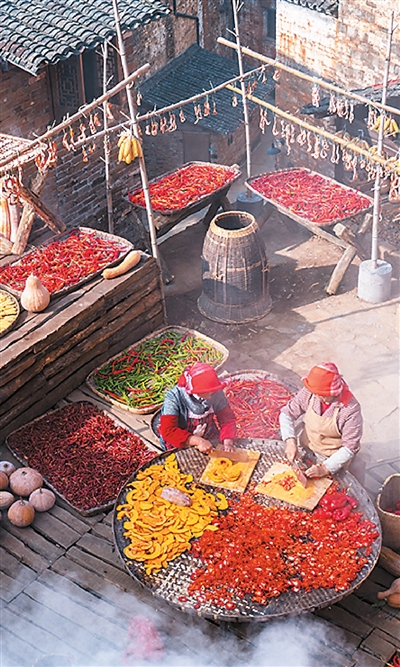




- BRNN
- BRI News
- BRNN News
- Database
Official Documents Polices and Regulations
Inter-government Documents International Cooperation BRI Countries
Business Guide Economic Data BRI Data
Trade
Investment Projects Latest projects
Cases - Content Pool

Villagers slice and dry chili peppers and pumpkins in Huangling village, Wuyuan county, east China's Jiangxi Province. (Photo courtesy of Huangling scenic spot)
Following China's bustling National Day holiday, transportation and accommodation costs have dropped significantly, and many regions have entered their prime season for appreciating autumn scenery, prompting numerous travelers to hit the road.
A wave of autumn tourism blending cost-effectiveness with distinctive experiences is sweeping across China. The tourism industry is enriching its offerings and fueling travelers' enthusiasm—vividly illustrating how innovation is transforming the traditional off-season into a peak period for travel.
Data from the online travel platform Qunar show that domestic airfares for departures between Oct. 13 and 31 fell by 36 percent compared with the National Day holiday period, while average prices at chain hotels dropped nearly 30 percent.
Recently, multiple flight routes—including Guangzhou-Shenyang, Chengdu-Harbin, and Shanghai-Xishuangbanna—were priced at just 400 yuan (about $56.2) to 500 yuan on average.
According to the big data research institute of Qunar, a growing number of travelers from north China are heading to Kunming, Xiamen, Zhuhai, Nanning, Xishuangbanna, and Huizhou to escape winter. Airlines have added routes to southern destinations, with flight bookings to Mangshi up 48 percent year on year and to Pu'er up 27 percent from the same period last year.
Traditionally, off-peak travelers tended to be older, but this year has seen a marked shift toward younger demographics. Statistics from online travel agency Tuniu show that travelers in their 30s and 40s now account for nearly 60 percent of off-peak bookings.
"In recent years, I've taken annual leave during the tourism off-season to avoid crowds, spend less, stay in better hotels, and enjoy a more relaxed vacation," said Beijing resident Ms. Li. "I just spent a week in Dali, strolling through the ancient town and around Erhai Lake and soaking up the sunshine. It was incredibly comfortable," she added.
Many office workers are striking a balance between affordability and quality experiences by taking annual leave or extending leave to avoid holiday crowds, flexibly arranging their schedules for more comfortable trips.

Aerial photo shows a stunning autumn view of Eryuan county, Dali Bai Autonomous Prefecture, southwest China's Yunnan Province. (Photo/Luo Xincai)
Data from the online travel platform Mafengwo show that searches for "where to go in autumn" have recently surged 160 percent month on month.
Huangling scenic spot in Wuyuan county, east China's Jiangxi Province, has gained popularity thanks to its agricultural tradition of drying crops in the sun each autumn. Recent data from the scenic area show daily visitor numbers exceeding 15,000, with weekend crowds surpassing 20,000.
Deep in the Qinling Mountains in Liuba county, northwest China's Shaanxi Province, the aroma of dishes filling the old street feast and the colorful crop-drying scenes in Jiangkou town have drawn visitors seeking unique seasonal experiences.
To build on the momentum of autumn tourism, regions across China have launched autumn-winter tourism campaigns, exploring new approaches through cultural empowerment, cross-sector integration, and regional coordination—further enriching off-season travel options.
The recent 2025 Beijing Chaoyang International Light Festival attracted crowds of residents and visitors. Chaoyang district in Beijing deployed 53 distinctive light and shadow installations, delivering dazzling artistic experiences. The festival hosted multiple events integrating culture, commerce, tourism, sports, and wellness, effectively activating off-season tourism consumption potential and helping boost Beijing's cultural tourism market.

Tel:86-10-65363107, 86-10-65368220, 86-10-65363106